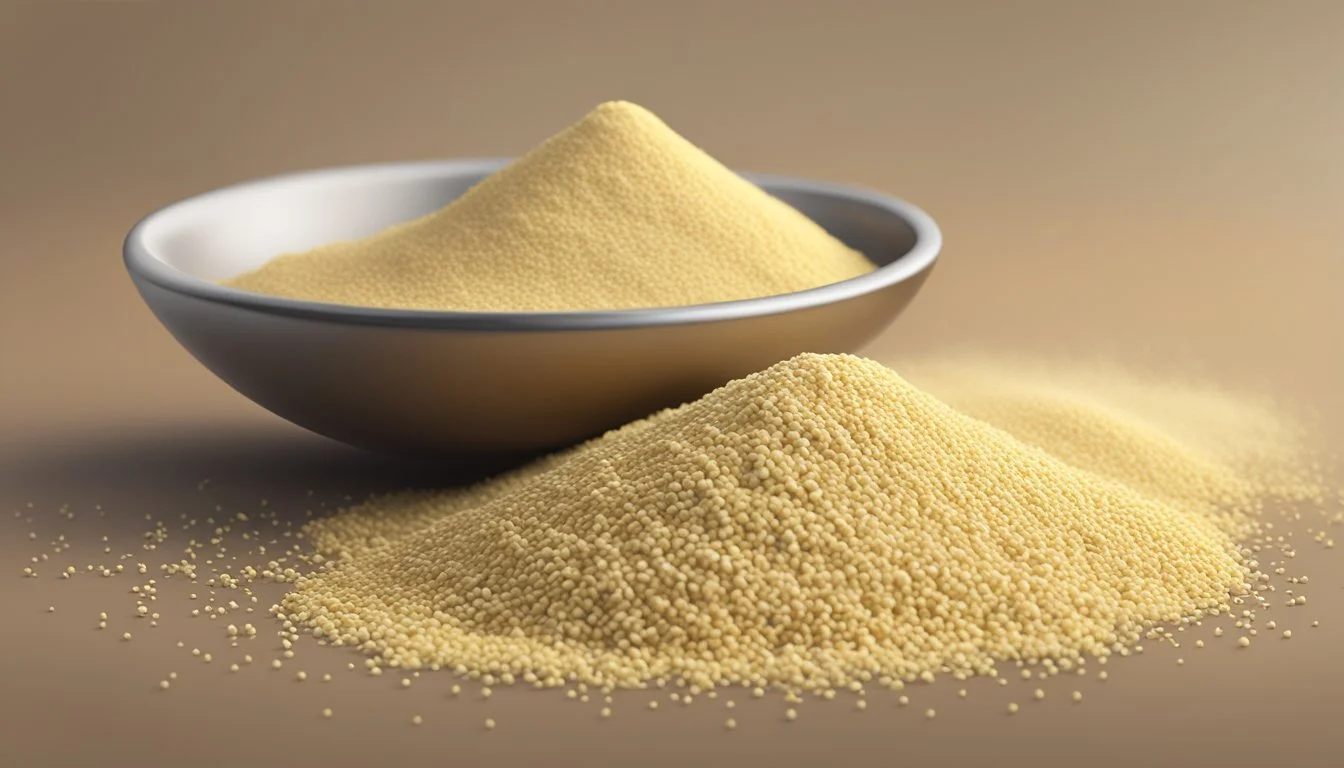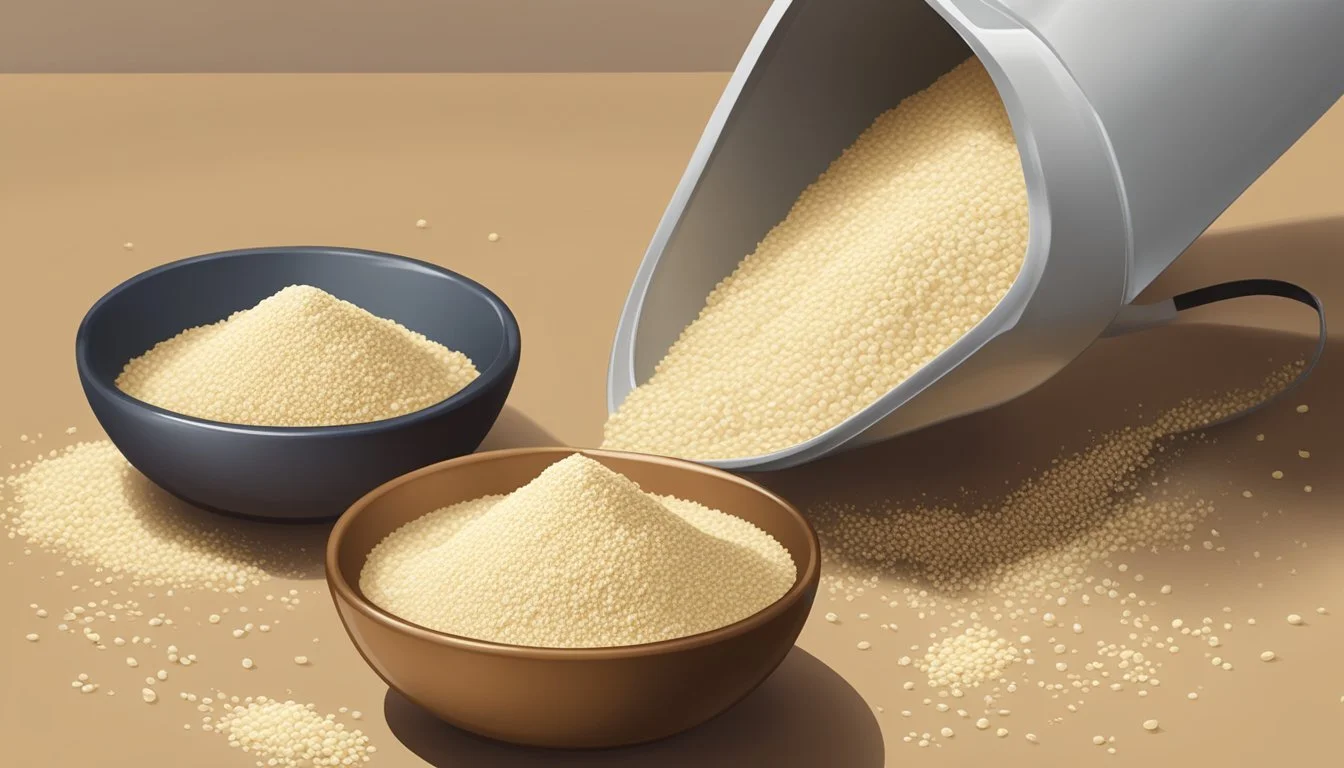How Many Tablespoons in a Pound of Millet Flour?
Measuring Guide Explained
When cooking or baking, precise measurements are crucial for achieving the desired results, especially when converting quantities between different units. Millet flour is a gluten-free alternative that is becoming increasingly popular due to its nutritional benefits. One pound of millet flour is equivalent to approximately 60.99 tablespoons. Such a conversion is essential for culinary professionals, home cooks, and anyone with dietary considerations who need to measure their millet flour from a larger bulk purchase into usable quantities for recipes.
Converting from pounds to tablespoons involves a straightforward multiplication when dealing with millet flour. As different flours can have varying densities, it is important to use the appropriate conversion ratio for millet flour specifically. This ensures recipes are followed accurately and dietary regimes are maintained without discrepancy. Understanding the equivalency between weight and volume with ingredients like millet flour makes recipe adaptation and ingredient substitution both efficient and reliable.
Using the correct conversion of millet flour from pounds to tablespoons affects the texture and consistency of the final product. By applying the specific conversion of approximately 60.99 tablespoons to one pound of millet flour, one can confidently proceed with recipes that call for precise measurements without compromising the dish's integrity. Whether scaling a recipe up or down, or simply portioning out flour for future use, knowing this conversion is an invaluable part of kitchen knowledge.
Understanding Pounds as a Unit of Mass
A pound is a unit of mass widely used in the United States and other regions that adhere to the US customary system. Precisely, one pound (lb) equates to 16 ounces (oz), demonstrating its relevance as a base unit for weight measurement in this system. Furthermore, it plays a critical role in everyday commerce and personal activities, serving as the common language for expressing weights in various contexts.
In the metric system, the pound is conveniently convertible to grams and kilograms. Specifically, one pound is equivalent to approximately 453.59 grams (g). This facilitates a straightforward method to switch between the two systems: by multiplying pounds by this conversion factor to obtain the gram equivalent and then dividing by 1,000 for the weight in kilograms (kg).
A brief comparison of mass units:
Unit Equals 1 pound 16 ounces 1 ounce 28.35 grams 1 pound 0.45359 kilograms
Understanding these conversions is vital for tasks like baking or shipping, where precise weight calculations are necessary. When calculating how many tablespoons are in a pound of millet flour, one first considers the flour's density. Since the density of millet flour differs from water and other substances, conversion requires this specific information to ensure accuracy.
Basics of Millet Flour
Millet flour, derived from the small-seeded grasses of the millet plant, stands out as a gluten-free flour option packed with nutrients. Its unique properties make it suitable for a variety of baking applications.
Nutritional Values
Millet flour is rich in essential nutrients that contribute to a balanced diet. Notably, it contains:
Proteins: An important macronutrient necessary for muscle repair and growth.
Fibers: Aids in digestion and helps maintain a healthy gut.
Vitamins: Particularly B vitamins, which are crucial for energy metabolism.
Minerals: Such as magnesium, phosphorus, and iron, supporting bone health and oxygen transport in the blood.
A detailed breakdown of millet flour's nutritional content per 100 grams is as follows:
Nutrient Amount Calories 374 kcal Protein 11 g Fat 4 g Carbohydrates 73 g Fiber 8.5 g Iron 3 mg
Common Uses in Baking
Millet flour's versatility in baking is notable, as it can replace or complement other flours in recipes. Commonly used in:
Bread: Its mild, slightly nutty flavor enhances bread without overpowering other ingredients.
Cakes: Gives cakes a tender crumb and pairs well with other gluten-free flours for structure and taste.
Pastries: As a gluten-free option, it is often mixed with other flours to achieve the desired texture.
Millet flour's gluten-free characteristic makes it a popular choice for those with gluten sensitivities or celiac disease. When used in baking, it requires consideration of its properties to ensure the final product has the right texture and structure.
Conversion Fundamentals
When converting between different types of measurements, it's important to understand the distinction between volume and mass, as well as how the density of an ingredient can affect measurements. Accurate conversions are crucial in culinary practices to ensure recipes are prepared correctly.
Volume vs. Mass
Volume measures the space an ingredient occupies, commonly represented in liters, milliliters, cups, and tablespoons. Mass, on the other hand, indicates the amount of matter in an ingredient, generally expressed in grams or pounds. When dealing with measurements in cooking, the specific unit of measure can significantly affect the outcome of a recipe. A volume unit like a tablespoon isn’t directly interchangeable with a mass measurement such as a pound without considering the density of the material being converted.
Density and Ingredient Measurement
Density plays a pivotal role in converting between volume and mass. It is defined as mass per unit volume and varies with temperature and pressure. Ingredient measurements based on volume (such as tablespoons) become more complicated with ingredients like millet flour due to varying densities. To convert a pound of flour to tablespoons accurately, density must be taken into account:
Millet Flour: 1 tablespoon = 0.016 pounds (approx. depending on density)
Given the density of millet flour, the calculation to convert it to tablespoons involves dividing the mass (pounds) by the weight of one tablespoon of millet flour. The accuracy of conversions between volume and mass requires appropriate density values for the ingredient in question.
Conversion Guide for Millet Flour
In baking and cooking, precise measurements are essential for the best results, especially when dealing with ingredients like millet flour. This section provides a straightforward guide to converting millet flour from weight to tablespoons and elaborates on the typical weight to volume conversions.
Millet Flour to Tablespoons
To convert millet flour from pounds to tablespoons, one must first understand the specific density of millet flour. Assuming millet flour has a similar density to all-purpose flour, one pound of millet flour is approximately equal to 3.62 cups or 58 tablespoons as inferred from general flour conversion rates. This, however, is an approximate since different flour types can have varying densities.
Weight to Volume Conversion
For weight to volume conversion of millet flour, the following ratio can be applied:
1 pound of millet flour = 16 ounces = ~453.6 grams
1 ounce of millet flour = ~28.35 grams
1 tablespoon of millet flour = approximately 8-9 grams, depending on the compaction and moisture of the flour.
To convert from pounds to tablespoons, one could use the following calculation as a guide:
Measure the weight of millet flour in pounds.
Convert pounds to grams by multiplying by 453.6.
Divide the gram measurement by the approximate grams per tablespoon (8 or 9) to find the number of tablespoons.
For instance, to convert 1 pound of millet flour to tablespoons:
1 pound = 453.6 grams
453.6 grams ÷ 9 grams per tablespoon ≈ 50.4 tablespoons (assuming a lighter scoop)
453.6 grams ÷ 8 grams per tablespoon ≈ 56.7 tablespoons (assuming a heavier scoop)
Note: These conversions are estimates and can be impacted by factors such as the grind of the millet flour and its settling in the container. It's always best to weigh flour for the most accurate measurement in baking.
Working with Different Flours
In baking, every flour type behaves differently, especially when substituted by weight. This section helps distinguish between all-purpose and millet flour, explaining the nuances in their substitution.
All-Purpose Flour vs. Millet Flour
All-purpose flour, refined from wheat, is the most commonly used flour in baking due to its moderate protein content, making it suitable for a wide range of baked goods. One pound of all-purpose flour is roughly equivalent to 3.5 to 3.6 cups, depending on the way it's scooped or sifted. Millet flour, on the other hand, is gluten-free and derived from a small-seeded grass, typically lighter in weight compared to its all-purpose counterpart. A pound of millet flour equates to approximately 3.25 to 3.5 cups.
FLour Comparisons:
Flour Type Weight per Cup (approx.) Best Used For All-Purpose Flour 4.5 oz General Baking Millet Flour 4.2 oz Gluten-Free and Nutrient-Dense Baking
The texture of millet flour is finer and it has a mildly sweet flavor, setting it apart from the neutral taste of all-purpose. One must consider these characteristics when using different flours for baking.
Substituting Flours
When substituting flours, bakers must account for differences in protein content, density, and baking properties. For example, bread flour, with a higher protein content, is better suited for chewy breads, whereas cake flour's fine texture and lower protein content create tender cakes. Substituting millet flour for all-purpose flour by volume can be challenging; it's advisable to use a weight conversion for better precision.
Substitution Tips:
To replace all-purpose flour with millet flour, use a ratio of 1:0.93, meaning for every cup of all-purpose flour, use approximately 0.93 cups of millet flour.
For gluten-free baking, a combination of flours, like almond and rice flour with millet, can emulate the structure provided by wheat flours.
In recipes that require self-rising properties, combine millet flour with a leavening agent, as it does not naturally contain any.
One can substitute other whole grain flours such as rye flour or whole wheat flour for all-purpose in recipes; however, adjustments to liquid content may be necessary due to their higher absorption rates. It's crucial to understand the properties of each flour to predict how they will react when mixed with other dry ingredients.
Measuring Ingredients Accurately
Accurate measurement is essential to baking and cooking success, ensuring flavors are balanced and recipes turn out as intended. Precision in measuring both wet and dry ingredients can make or break a dish.
Dry vs. Wet Ingredients
Dry ingredients, such as millet flour, require a different approach than wet ingredients like milk or water. For dry ingredients, chefs typically use measuring cups or scales, while wet ingredients are best measured in containers with pouring spouts to gauge volume correctly. When measuring millet flour, one should spoon it into a measuring cup and level it off with a straight edge to avoid packing.
Table: Dry and Wet Ingredients Measuring Units
Ingredient Type Unit of Measurement Dry Ingredients Cups, Teaspoons, Tablespoons Wet Ingredients Fluid ounces, Cups, Tablespoons
Avoiding Errors and Omissions
To prevent errors and omissions, never scoop directly from a flour bag as it can lead to over-measuring. Instead, fluff up the flour with a spoon, lightly spoon it into your measuring cup, and level it off. For wet ingredients, ensure the measuring cup is on a flat surface and eyeball the level at eye height. It’s key to use the right measuring tools: teaspoons for small amounts, graduated measuring cups for larger volumes of dry ingredients, and liquid measuring cups for fluid ingredients like oil, milk, or water.
A common error is using fluid-ounce measurements for dry ingredients, which compromises the ratio of components like granulated sugar in the mix. Components like butter may be measured by weight or by using a wrapper with markings indicating tablespoons or cups. With eggs, it is assumed that one large egg contributes about 3 tablespoons of liquid to a recipe.
By following these guidelines, one ensures their measurements of millet flour and other ingredients are as accurate as possible, leading to reliable and tasty results.







